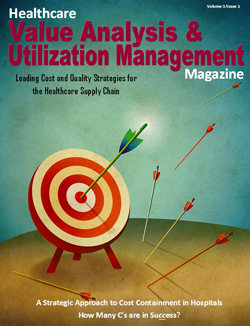An Interview with Dr. Rhonda Sullivan, DNP, PhD, MSN, MBA, CWON, LNCC, NE-BC, CSPHA
HCVAM: How did you get involved with advanced wound care in the healthcare value analysis world?
RS: My experience goes back 21 years. Since getting into wound care, I always had the opportunity to participate in the value analysis of the product purchasing decisions. I was just lucky enough to work in a system where the wound care clinicians were always involved in the advanced wound care decision-making process.
I think those experiences always resonate with me the most, especially when I was the chair of our enterprise wound care and pressure injury prevention committee. What happened across our system was that we were charged with converging practice and products. So, when we moved to the advanced wound care category, the wound care nursing representatives from every facility sat on that overarching value analysis committee. What was unique about that was that it allowed us to really get that 360-degree review of our products and the needs of our patients across the entire system, as well as the relevant evidence demonstrating outcomes. We looked for opportunities to have diversity in our products, but also products that serve multiple functions. Interestingly, cost was really the last thing we looked at, mainly because the clinicians were looking at all the other components related to patient care. This team was unique because although the wound clinicians were the leads with advanced wound care, the overarching team was multidisciplinary.
This approach allowed us to have subject matter experts, that could be broken out into smaller work groups that would represent their facility to the larger group, for any product category we were looking at. Our system was 15 hospitals so getting them all to have the same products, policies across the system, and evaluating these with the highest level of evidence with the purpose of best outcomes was the goal. Having 15 wound care nursing experts making the decisions was a major accomplishment. We made decisions by consensus based on an evaluation of everything that was relevant to that product decision. It really opened the door to wound care being well-managed with aligned policies and products at all the system’s facilities.
HCVAM: Please tell us how advanced wound care is improving outcomes for patients as well as clinicians’ ability to have better options for treatment.
RS: I’ve been a nurse for 30 years. Twenty-one of those years have been in wound care, so I have been able to see this specialty evolve over the years. I was able to see the transformation of the advanced wound care space. This really improved the way we cared for patients because the products that we were now able to access did actively help adjunct deficits in the patients’ wound environment or the patients’ healing abilities. In making the move to advanced wound care, we were able to achieve things like undisturbed wound healing, where we went from dressing changes three times a day to maybe twice a week or even once a week.
Now you’re getting better outcomes because we know that we’re insulating the wound and allowing the body to heal itself while providing a moist environment. This also helped with the nurses’ workload. Can you imagine the time consumed with dressing changes three or four times a day for a nurse who must attend to seven patients? We were able reduce the number of dressing changes, reduce the decision-making process, and really streamline it so that there were clear differentiators in what would work for the patients. Most significantly, the evidence really supported what would work for healing. When you chose those wound care products, you could depend on them to do the job that they’re expected to perform.
Another big win is alleviating waste. Many people think that normal saline, wet to dry three times a day is cheap, but I’ve performed that cost analysis. The analysis was at a facility I was working with on advanced wound care product introduction. We found that when you factor in the gauze, normal saline, scissors, and Q-tips, not to mention the nursing time and extended period of pain and suffering for the patient, this was much more expensive. Switching from dressing changes four times a day to two times a week optimized both the healing and labor elements. The outcomes spoke for themselves – better and faster healing for the patient.
HCVAM: Most important for healthcare value analysis professionals today is the focus of the triple aim of cost, quality, and outcomes. How do they manage advanced wound care to meet these ever-rising goals?
RS: I think there’s a bigger story to value analysis and healthcare purchasing than just cost. You must look at total value. You have to look at how the decisions you make affect your quality and your outcomes; all of your outcomes, not just treatment or healing rate, but your overall functional use. Are you changing the dressing three times a day but could really go to twice a week because the dressing you are currently using is inferior, the tape is not as adhesive as it is supposed to be, or because it doesn’t have good absorption?
You want products that perform in a way that supports optimal quality and outcomes. You get your savings through removing redundancy by having products that are diverse and can address a number of issues. You get your savings through getting support of your practice. Be proactive and look for educational opportunities from your integrated vendor partners that can extend your organizational knowledge. Look for tools that help with clinical decision-making that make a difference in the end result of quality and outcomes. The focus needs to be on total value, and the value beyond just the price of the product is key.
HCVAM: Advanced wound care is a growing spend area year in and year out at healthcare organizations. What can value analysis and supply chain professions do to manage these utilization costs better, other than just switching vendors for a better price?
RS: You should start off with looking at the partners that you already have and assess what products they offer that can meet your needs. Think about how you can standardize across your entire portfolio, ideally with one or two vendors who can meet all of your needs. What you’re going for is to streamline your unit utilization. By doing this, you will get rid of waste and redundancy because you only have two vendors providing what you need. And I say two, but it might be one that could meet all of your needs. If you can, leverage the partnerships that you have already and then work towards negotiated sole source contracting, if possible. This builds a relationship with that vendor so that they are an integrated partner charged with meeting your needs across the wound care continuum. The biggest thing to consider if you are planning a switch is to consider not just price, but look at the evidence, look at the outcomes that product has produced. Look at the services and support that come along with partnering with that vendor. Yes, reliable products are part of a bigger picture of best practice and quality outcomes, but you want an integrated partner who can help you with all of it across the board, not just give you a cheaper product.
HCVAM: What are some best practices that you could offer to value analysis professionals that would help them with advanced wound care product evaluations, evidence analysis, standardization, and utilization?
RS: First for me is to be customer focused. In healthcare, the customer is the patient first, the end user second, and then the organization third. Always keep the patient within your priorities. Secondly, develop a collaborative multidisciplinary team – a team where there is an exchange between value analysis and the subject matter experts on all relevant decisions so that you ensure that the stakeholder and the voice of the customer is represented in the decisions. One of the situations I often come upon with wound care decisions is that many times value analysis teams think that they don’t have to consider some decisions because they don’t really affect the bedside nurse or the clinician.
A good example is when the supply chain VA team at one of our facilities decided they wanted to change Q-tips and they didn’t ask anybody because it’s just a Q-tip. It’s a common generic product, so why not just switch it out? Then we found out that we had Q-tips that were always fraying in the wounds and inevitably took the nurses longer to do wound care because we had to pick out the frayed Q-tip as well as make sure the new one did not fray in the wound. This change was reversed in our facility in less than a week because it put our patients at risk and wasted nursing time. Something so simple had such a far-reaching effect. Another example of this is tape. The wound care nurses cannot accept a change of tape unless a full-blown trial is performed because it will have a dramatic effect on wound care. It’s not just tape.
HCVAM: What can value analysis professionals expect from advanced wound care product lines in the near future?
RS: Wound care just keeps getting better and better. The first thing that can be expected from wound care product lines is more innovation as the products continue to evolve as we learn more about wound healing. Products will be created that will help better care for patients that optimize the healing environment, improve outcomes, reduce waste, and minimize complications of care. You will see vendors wanting to be more integrated in their clients’ practice to be better partners in their outcomes, and to help with operational efficiency to standardize across multiple service lines and be a part of that continuum of care.
Rhonda Sullivan, DNP, PhD, MSN, MBA, CWON, LNCC, NE-BC, CSPHA is a Registered Nurse with close to 30 years’ experience. Twenty years have been dedicated to the wound and ostomy specialties. She is board-certified as a Nurse Executive, Wound-Ostomy Nurse, Legal Nurse, and Safe Patient Handling Associate. She is a published author, award-winning researcher, med-legal expert, approved CE provider for the Florida Board of Nursing, and an international speaker on pressure injury prevention and deep tissue pressure injury.
Dr. Sullivan is currently employed as the Clinical Director of Wound Care Marketing for Molnlycke Health Care. In this role, she serves as clinical consultant to Academic Medical Centers and Magnet-designated healthcare facilities, with a focus on reducing waste and redundancy in care and improving clinical and financial outcomes by alleviating avoidable hospital-acquired conditions.
Articles you may like:
Hospital Value Analysis Best Practice: The Voice of the Customer Needs to Be Heard





